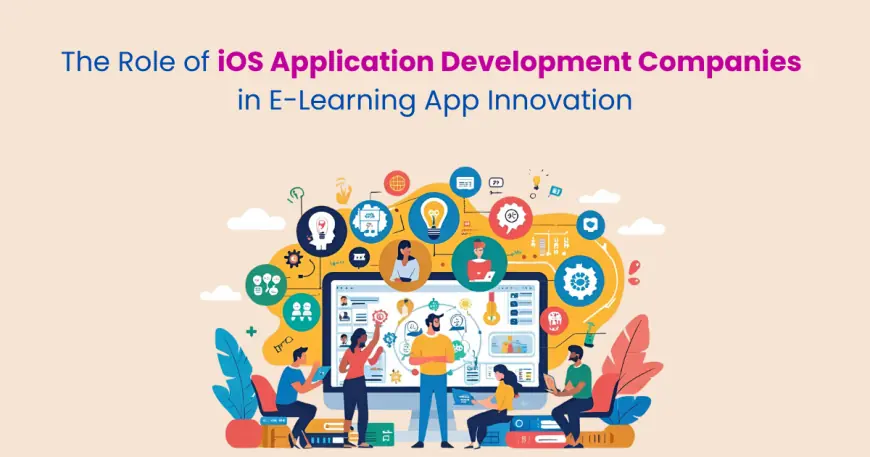The Role of iOS Application Development Companies in E-Learning App Innovation
Learn how iOS Application Development Companies are shaping e-learning app innovation with seamless UX, scalability, and smart tech integration.

The digital revolution in education has been accelerated by mobile technologies, especially with the global shift toward remote and hybrid learning. iOS, with its premium user base, high device performance, and stringent security protocols, has emerged as a top choice for delivering seamless learning experiences. iOS application development companies have played a pivotal role in enabling this transformation by building highly responsive, secure, and engaging e-learning applications that cater to diverse user segments—from school children to corporate professionals.
These companies blend technical skillsets, UI/UX creativity, and edtech domain expertise to deliver learning platforms that are not just functional, but transformative.
Why iOS for E-Learning Apps? (Expanded)
iOS is Preferred for E-Learning Because:
-
High User Engagement: iOS users typically show greater app usage frequency and retention, which is crucial for learning continuity.
-
Performance Optimization: Apple’s tightly integrated hardware and software ensures fewer crashes and faster load times, resulting in a superior user experience.
-
Affluent User Base: Many institutions and corporate users prefer iOS devices for education, enabling monetization through subscriptions, paid courses, and in-app purchases.
-
Security & Privacy: Apple’s rigorous app review process, Face ID, and encryption protocols ensure that sensitive student data remains protected.
-
Brand Trust: Educational institutions often align themselves with premium platforms like iOS to reflect quality and innovation.
How iOS Application Development Companies Drive E-Learning Innovation
iOS development companies are not mere coders—they’re innovation partners.
User-Centric Design and Experience
They ensure the app feels intuitive across all age groups. For example:
-
Kids' learning apps use vibrant colors and large tap targets.
-
Corporate e-learning apps offer minimalist dashboards with data visualizations for tracking progress.
Customized Learning Paths
Through Core ML and AI tools, companies can:
-
Deliver lesson recommendations based on past performance.
-
Adjust difficulty levels dynamically.
-
Provide instant feedback for assessments.
Gamification & Interactivity
Leading developers use Apple’s GameKit, ARKit, and SceneKit to:
-
Add 3D flashcards.
-
Offer immersive AR-based biology models.
-
Include level-based progression, quizzes, and badge systems.
Real-Time Assessments & Analytics
By integrating iOS-native analytics and Firebase, developers build:
-
Real-time dashboards for teachers and students.
-
Instant report cards after quizzes.
-
In-app analytics for engagement tracking.
Key Features Developed by iOS App Experts in E-Learning Apps
Here are crucial features that set top-performing iOS e-learning apps apart:
-
Live Classes & Video Streaming: Using AVKit and WebRTC, companies enable live interactions and HD streaming.
-
AI-Based Learning Recommendations: Core ML enables intelligent course suggestions and pacing customization.
-
Offline Access: Smart caching lets users download lectures, quizzes, and notes for offline use.
-
Face ID/Touch ID Login: Enhances security and user convenience, especially in school apps.
-
Gamified Learning Modules: Motivates users via challenges, points, leaderboards, and virtual rewards.
-
In-App Chat & Collaboration: Enables peer-to-peer and student-teacher communication through secure, moderated channels.
-
Digital Certificates: Auto-generation of course completion certificates using PDFKit and digital signatures.
Technologies Powering Modern iOS E-Learning Apps
|
Technology |
Application in E-Learning |
|
Swift & SwiftUI |
For fast, declarative UI development and rich animations. Helps create smooth interactive course modules. |
|
ARKit |
To build immersive, 3D learning environments (e.g., dissecting a virtual frog). |
|
Core ML |
Enables on-device machine learning to deliver personalized learning paths without needing a cloud connection. |
|
CloudKit |
Facilitates real-time sync across devices for course materials and user progress. |
|
AVKit |
Provides advanced multimedia controls like picture-in-picture and closed captions. |
|
PushKit |
Sends timely class reminders, quiz notifications, and progress updates. |
Success Stories of iOS-Based E-Learning Apps
Duolingo
-
iOS users are 25% more active on Duolingo than Android users.
-
The iOS app integrates real-time feedback, push notifications, and goal setting—resulting in a sticky user experience.
Khan Academy
-
Their iOS app includes voice-over support, downloadable videos, and intuitive touch interactions—all crafted for Apple devices.
BYJU’S
-
Uses Apple Pencil compatibility for interactive whiteboarding.
-
Advanced AR-based science simulations are developed using iOS-exclusive frameworks.
These apps set benchmarks for what’s possible when expert iOS developers combine tech with pedagogy.
Benefits of Hiring an iOS Application Development Company
Why not just hire freelancers or build in-house?
-
Specialized iOS Expertise: These companies bring years of experience in building apps that pass Apple’s stringent review process.
-
Agile Delivery: With agile sprints, they rapidly prototype and iterate learning modules based on real-world feedback.
-
UX/UI Mastery: They understand how learners interact on iPhones/iPads, especially with VoiceOver, Dynamic Type, and Haptics.
-
Ongoing Optimization: Post-launch, these companies provide bug fixes, performance tuning, and regular feature updates.
Challenges and How These Companies Overcome Them
|
Challenge |
iOS App Company’s Solution |
|
App Store Rejections |
Thorough compliance testing against Apple Human Interface Guidelines. |
|
Device Compatibility |
Use of simulators and real devices to ensure the app works across iPhone, iPad, and macOS (for Catalyst apps). |
|
Data Privacy Regulations |
Integration of GDPR, FERPA, and COPPA-compliant frameworks. |
|
Real-Time Collaboration |
Use of low-latency protocols (e.g., WebSockets, WebRTC) to ensure smooth audio/video sessions. |
These challenges require both domain and platform expertise—which top iOS application development companies possess.
Future Trends in iOS E-Learning App Development
What to expect next?
-
On-Device AI: With Core ML 4+, iPhones can process student data locally—ensuring privacy while personalizing learning.
-
Gesture-Based Learning: Using VisionKit and accelerometer APIs, students can interact with apps via hand gestures and motion controls.
-
Voice-Based Interfaces: SiriKit will allow students to say, “Hey Siri, start my math lesson” and jump right into content.
-
AR-Enabled Learning Spaces: Imagine placing a virtual solar system in your room with an iPad—this is already possible with ARKit 6.
-
Neural Engine Integration: Enables lightning-fast image/audio recognition for language learning and accessibility.
Conclusion
iOS application development companies are driving the future of e-learning innovation. By leveraging Apple’s evolving ecosystem and pushing the boundaries of what’s possible in mobile learning, they create applications that are more than just functional—they’re engaging, personalized, and transformational.
Whether you're an edtech startup or a traditional education provider looking to go digital, partnering with a skilled iOS development team can help you build high-performing apps that stand out in the crowded App Store and genuinely help learners succeed.
FAQs
1. Why choose iOS over Android for e-learning apps?
iOS offers a more premium audience, stricter app quality standards, smoother UI performance, and advanced security features.
2. Can iOS development companies help integrate LMS platforms like Moodle or Blackboard?
Yes. Experienced iOS developers can integrate third-party APIs or build custom plugins for LMS systems.
3. Is Swift the only language used for iOS e-learning apps?
While Swift is the modern standard, some companies still use Objective-C for legacy projects. SwiftUI is now widely adopted for new projects.
4. How long does it take to build an iOS e-learning app?
Depending on features, timeline ranges from 8 to 20 weeks for MVPs and 6+ months for full-featured products.
What's Your Reaction?
 Like
0
Like
0
 Dislike
0
Dislike
0
 Love
0
Love
0
 Funny
0
Funny
0
 Angry
0
Angry
0
 Sad
0
Sad
0
 Wow
0
Wow
0


















































